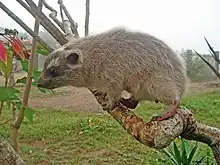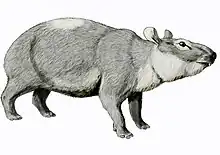| Tree hyraxes[1] | |
|---|---|
 | |
| Western tree hyrax, Dendrohyrax dorsalis | |
| Scientific classification | |
| Domain: | Eukaryota |
| Kingdom: | Animalia |
| Phylum: | Chordata |
| Class: | Mammalia |
| Order: | Hyracoidea |
| Family: | Procaviidae |
| Genus: | Dendrohyrax Gray, 1868 |
| Type species | |
| Hyrax arboreus A. Smith, 1827 | |
| Species | |
The tree hyrax or tree dassie is a small nocturnal mammal native to Africa. Distantly related to elephants and sea cows, it comprises the four species in the genus Dendrohyrax, one of only three genera in the family Procaviidae, which is the only living family within the order Hyracoidea.
The four species are:
| Image | Common Name | Scientific Name | Distribution |
|---|---|---|---|
 | Southern tree hyrax | D. arboreus | East and Southern Africa[2] |
 | Eastern tree hyrax | D. validus | East Africa.[3][4] |
| Benin tree hyrax | 'D. interfluvialis | West Africa.[5] | |
 | Western tree hyrax | D. dorsalis | West and Central Africa[6] |
Analysis of calls found that they could be divided into 'shrieking' hyraxes and 'barking' hyraxes, with the barkers being a genetically distinct fourth species.[7]
The tree hyrax has four-toed front feet and three-toed back feet with rounded nails, and rubbery soles that help it climb.[8]
Colouring
Dependent on geographical location, their soft dense coats can range from a pale gray to light or dark brown. The variation is consistent with evolutionary development to aid with camouflage, so that in wetter regions with more verdant and abundant vegetation, they are darker, and in more arid areas, their colouring is lighter.
Habitat
The habitat of the tree hyrax is mostly in forested places with a mix of older and younger trees. It can be found in elevations up to 4500 m above sea level.
Despite being more common than the rock hyrax, the tree hyrax is much more difficult to spot, as it is both nocturnal and extremely shy.
Habitat assessment
Tree hyraxes are nocturnal, arboreal folivores, which make use of cavity-bearing trees as dens in forests whereforest fauna decreased due to the change in the structural nature of forests in Eastern Cape, South Africa. Studies which were used to study the specific habitat requirements of fauna in their forest, revealed that the tree hyrax was found to select for den trees with particular characteristics: seven tree species were selected as den trees, which were usually the tallest trees in the canopy 4–8 m. Den trees were usually only partly decayed, with multiple cavity entrances and trunk angles between 45 and 68°. Cavity entrance and orientation did not appear to play a role in den tree selection by Dendrohyrax spp.[9]
Activity and calling patterns
Tree hyraxes were found to be active 16% of the time, during which feeding was their most dominant activity. They mostly feed themselves on leaves of Hagenia abyssinica. Of the 16% active time, 4% of the time was used travelling between trees predominantly during daylight hours. They have calling behavior that is strongly prevalent in the dry season. The hyrax calls regularly in the early evening, and often a second time later at night; during rains, though, their calls become infrequent.[10]
Diet
The tree hyrax diet is plant-based and varies depending on geographical location. In one South African forest, their principal foods were Schotia latifolia, Cassine aethiopica, and Eugenia natalensis.[11]
Territorial call
Each of the four species of tree hyrax has a distinct territorial call.[12] In D. validus, it starts with a series of loud, measured cracking sounds, sometimes compared to "a huge gate with rusted hinges being forced open". This is then followed by a series of "unearthly screams", ending in a descending series of expiring shrieks. Females also call, but lack the air pouches and enlarged larynges of the males, producing only a feeble imitation. Typically, two peak calling periods occur per night. Times vary, but the first period is often 2–3 hours after dark, and the second at some point after midnight.[8]
References
- ↑ Shoshani, J. (2005). Wilson, D.E.; Reeder, D.M. (eds.). Mammal Species of the World: A Taxonomic and Geographic Reference (3rd ed.). Johns Hopkins University Press. pp. 87–88. ISBN 978-0-8018-8221-0. OCLC 62265494.
- ↑ Butynski, T.; Hoeck, H. & de Jong, Y.A. (2015). "Dendrohyrax arboreus". IUCN Red List of Threatened Species. 2015: e.T6409A21282806. doi:10.2305/IUCN.UK.2015-2.RLTS.T6409A21282806.en.
- ↑ Roberts, D.; Topp-Jorgensen, E.; Moyer, D. (2013). "Dendrohyrax validus, Eastern Tree Hyrax". In Kingdon, J.; Happold, D.; Hoffmann, M.; Butynski, T.; Happold, M.; Kalina, J. (eds.). Mammals of Africa, Volue 1: Introductory Chapters and Adfrotheria. A&C Black. pp. 158–161. ISBN 978-1-4081-8996-2.
- ↑ Hoeck, H.; Rovero, F.; Cordeiro, N.; Butynski, T.; Perkin, A.; Jones, T. (2015). "Dendrohyrax validus". IUCN Red List of Threatened Species. 2015: e.T136599A21288090. doi:10.2305/IUCN.UK.2015-2.RLTS.T136599A21288090.en.
- ↑ Oates, John F.; Woodman, Neal; Gaubert, Philippe; Sargis, Eric J.; Wiafe, Edward D.; Lecompte, Emilie; Dowsett-Lemaire, Françoise; Dowsett, Robert J.; Gonedelé Bi, Sery; Ikemeh, Rachel A.; Djagoun, Chabi A. M. S.; Tomsett, Louise; Bearder, Simon K. (2022). "A new species of tree hyrax (Procaviidae: Dendrohyrax) from West Africa and the significance of the Niger–Volta interfluvium in mammalian biogeography". Zoological Journal of the Linnean Society. 194 (2): 527–552. doi:10.1093/zoolinnean/zlab029.
- ↑ Butynski, T.; Dowsett-Lemaire, F.; Hoeck, H. (2015). "Dendrohyrax dorsalis". IUCN Red List of Threatened Species. 2015: e.T6410A21282601. doi:10.2305/IUCN.UK.2015-2.RLTS.T6410A21282601.en.
- ↑ Rosti, Hanna; Pihlström, Henry; Bearder, Simon; Pellikka, Petri; Rikkinen, Jouko (December 2020). "Vocalization Analyses of Nocturnal Arboreal Mammals of the Taita Hills, Kenya". Diversity. 12 (12): 473. doi:10.3390/d12120473. hdl:10138/323576.
- 1 2 Estes, Richard D. (1999). The Safari Companion. Chelsea Green Publishing Company. ISBN 1-890132-44-6.
- ↑ Gaylard, A.; Kerley, G. I. H. (2001). "Habitat assessment for a rare, arboreal forest mammal, the tree hyrax Dendrohyrax arboreus". African Journal of Ecology. 39 (2): 205–212. Bibcode:2001AfJEc..39..205G. doi:10.1046/j.0141-6707.2000.301.x. ISSN 1365-2028.
- ↑ Milner, Jos M.; Harris, Stephen (1999). "Activity patterns and feeding behaviour of the tree hyrax, Dendrohyrax arboreus, in the Parc National des Volcans, Rwanda". African Journal of Ecology. 37 (3): 267–280. Bibcode:1999AfJEc..37..267M. doi:10.1046/j.1365-2028.1999.00184.x. ISSN 1365-2028.
- ↑ Gaylard, Angela; Kerley, Graham I. H. (1997). "Diet of Tree Hyraxes Dendrohyrax arboreus (Hyracoidea: Procaviidae) in the Eastern Cape, South Africa". Journal of Mammalogy. 78 (1): 213–221. doi:10.2307/1382654. ISSN 0022-2372. JSTOR 1382654.
- ↑ "Hyrax vocalizations". Hyrax vocalizations. Retrieved 6 October 2019.
External links
 Data related to Dendrohyrax at Wikispecies
Data related to Dendrohyrax at Wikispecies

